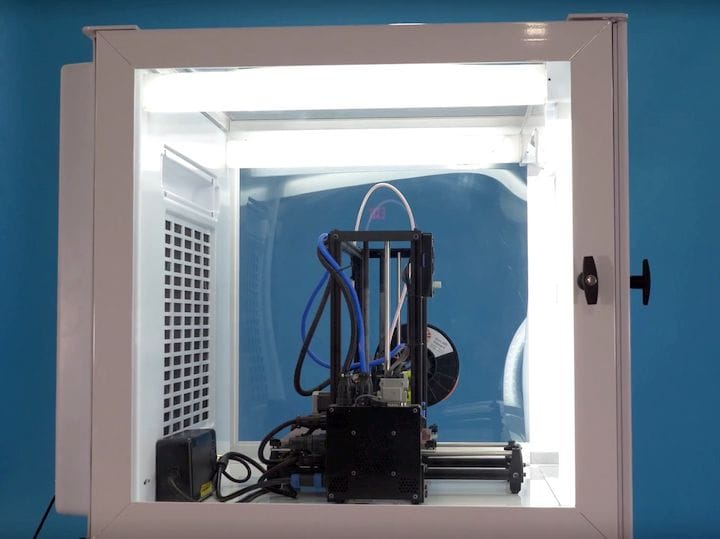![The 3DPrintClean system: should you increase your safety with this device? [Source: 3DPrintClean]](https://fabbaloo.com/wp-content/uploads/2020/05/image-asset_img_5eb0a166ab451.jpg)
We received responses from our provocative post last week, “Does ANYONE Care About 3D Printer Emissions?”
The post was written after attending formnext, where our team saw dozens, perhaps hundreds of machines, most of which either ignore safety concerns entirely, or have half-baked solutions that don’t really address the problem – but do enable the manufacturers to toot their horn about it.
It’s enough to drive any safety-minded person to despair, hence the rant last week.
Fabbaloo reader and frequent commenter Ben Reytblat provided one response pointing out that a company, 3DPrintClean, does provide a solution to several aspects of safety in 3D printing. He writes:
“Perhaps part of the reason you’re not seeing much action on the part of the manufacturers is that they have looked at the problem and came to the conclusion that the absolute amount of particles is tiny compared to other common household emissions – for example frying a chick[en] leg produces vastly more flying particulates. So the hazard is not viewed as being great.
Also, I think PLA is not considered dangerous: from what I’ve been told, PLA is safe for human implantation and is broken down, absorbed, and safely eliminated by the human body over time.
Of course, if we later find out that these emissions are dangerous at these levels, the manufacturers will have to improve their products. That will pretty much doom all of the least-expensive open-frame gantry machines, but that’s OK, the market will adjust.”
When I wrote the story, “Does ANYONE Care About 3D Printer Emissions?” I meant 3D printer MANUFACTURERS, who largely ignore safety concerns and focus on technical capabilities and price in their new machine designs. 3DPrintClean is not a 3D printer, but is an incredibly powerful accessory that more people should consider using.
We’ve written about the company several times previously. Four times, in fact:
When they first appeared on the market in 2015
When they released their first product to the public in 2015
When they introduced an inexpensive “tent-like” solution in 2016
When they introduced their advanced Model 3 series in 2017
Reytblat is entirely correct: the 3DPrintClean solution is about as close as you can come to a perfectly “safe” 3D printing environment. Their approach is to jazz up a sealed case that contains your otherwise unsafe 3D printer. And by “jazz up”, I mean it does these safety things:
-
Air filtration (both particles and VOCs)
-
Thermal runaway protection
-
Shatterproof case windows
-
Lockable doors
-
Automatic fire suppression
-
Door seals
-
Door sensors
-
Made from fire retardant materials
They even sell insurance in case you have a 3D printer fire that damages your enclosure or filter, they will replace it at no charge.
![A powerful safety solution for 3D printers [Source: 3DPrintClean]](https://fabbaloo.com/wp-content/uploads/2020/05/image-asset_img_5eb0a1671916f.jpg)
In addition to the safety features, 3DPrintClean’s system also provides a number of functional improvements:
-
USB passthrough to machine’s port
-
Touchscreen controls
-
LED lighting
-
In-chamber spool mounts
-
Noise suppression
-
Leveling feet
-
Humidity monitoring
-
Dehumidification
-
Heat retention
-
WiFi connection
-
Floor casters for easy movement
3DPrintClean’s filtration system includes a “UFP” (ultra fine particle) filter, but we cannot locate a specification for it. Nevertheless, the filter appears more capable than the poorly performing HEPA filters more often found in some 3D printers. There’s also a carbon filter that should remove a substantial amount of volatile organic compounds (VOCs).
It’s not a perfect solution, but it’s getting close.
One challenge some 3D printer operators will encounter is that the enclosures from 3DPrintClean are somewhat expensive, and in some cases will be more expensive than the printer itself. 3DPrintClean offers several different models with prices ranging up to US$2,995, and there are also options you can install that may add to that price.
What this tells me is that there is likely one or two thousand dollars that could (or maybe should) be added to the price of 3D printer equipment to ensure they also have such safety and utility features.
For some workshops, it actually may be less expensive to install an external ventilation system, and that can also be used for multiple machines, whereas the 3DPrintClean solution is good only for one 3D printer at a time.
Via 3DPrintClean











We were able to view video footage of the 3D printing hair-caught incident from last week and have determined exactly how it occurred, and how to prevent it from happening again.